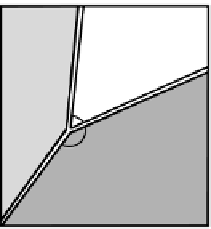Geoscience Reference
In-Depth Information
(a) Find the coordinates of the angular velocity vector of C to A and its amplitude.
(b) Draw velocity triangles for the triple junctions at b and d.
(c) Tritekton has a magnetic field that reverses every ten million years. Draw the
magnetic pattern created at the triple junction where extension is taking place.
State whether it is at b or d.
(d) The features at each plate boundary are trenches, transform faults or spreading
ridges. Describe their distribution along each plate boundary.
(Cambridge University Natural Sciences Tripos IB, 1979.)
7. In Fig. 2.26, the trench between B and C is consuming B only. The ridge between
A and B is spreading symmetrically at right angles to its axis. The pole of rotation
between A and C is fixed to C. The angular velocity of A with respect to C is in the
direction shown, and is 2
×
10
−
8
rad yr
−
1
in magnitude.
(a) Mark the poles of rotation and angular velocities of (i) plate B and (ii) the ridge
axis with respect to plate C. (Remember that the pole of motion between two
plates is that point which is stationary with respect to both of them.)
(b) Show the direction and rate of consumption at X and Y.
(c) How long will it take for the ridge to reach (i) X and (ii) Y?
Sketch the history of the triple junction between A, B and C with respect to C.
(Cambridge University Natural Sciences Tripos 1B, 1981.)
Plate A
2 cm yr
−
1
2 cm yr
−
1
Plate
C
Plate B
2 cm yr
−
1
2 cm yr
−
1
ω
Figure 2.26.
The map for
Problem 7.
Plate A
Plate B
60
o
8. The three plates A, B and C meet at a ridge-ridge-ridge triple junction as shown in
Fig. 2.27. The ridge between plates A and B has a half-spreading rate of 2 cm yr
−
1
.
Calculate
(a) the half-spreading rates of the other two ridges and
(b) the motion of the triple junction relative to plate C.
150
o
Plate C
9. All the plates of Problem 1 move rigidly without rotation. Discuss the difference
between those motions and the motions that would take place were the plates on the
surface of a spherical Earth. (For example, by how much would the plate-separation
rates vary along the length of the ridge between plates B and C?)
10. Four flat plates are moving rigidly, without rotation, on a flat Earth as illustrated in
Fig. 2.28.
(a) Determine the relative motion vector of the Beautific-Joker's-Nasty (BJN) triple
junction to the Albatross plate.
(b) Determine the relative motion vector of the Beautific-Nasty-Erratic (BNE) triple
junction to the Albatross Plate.
(c) Using these vectors, draw the loci of the future positions of these junctions relative
to the Albatross plate. Mark points at 10-Ma intervals.
(d) At 10-Ma intervals redraw the positions of the plate boundaries until both the
Joker's plate and the Nasty plate have been consumed at the subduction zone
boundary by the Albatross plate.
(e) Draw velocity triangles for the triple junctions at the times when they pass through
points A and B.
(f) Draw the magnetic-anomaly pattern formed by the BJN junction for 10 Ma,
assuming that a recognizable anomaly appears at 2-Ma intervals.
(From G. C. P. King, personal communication.)
Figure 2.27.
A
ridge-ridge-ridge (RRR)
triple junction.
6 cm yr
−
1
6 cm yr
−
1
JOKER'S
PLATE
ALBATROSS
PLATE
(assumed fixed)
BEAUTIFIC
PLATE
17 cm yr
−
1
NASTY PLATE
ERRATIC PLATE
2000 km
Figure 2.28.
Plates on a
flat Earth.








































